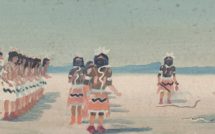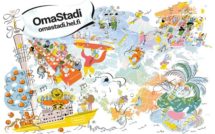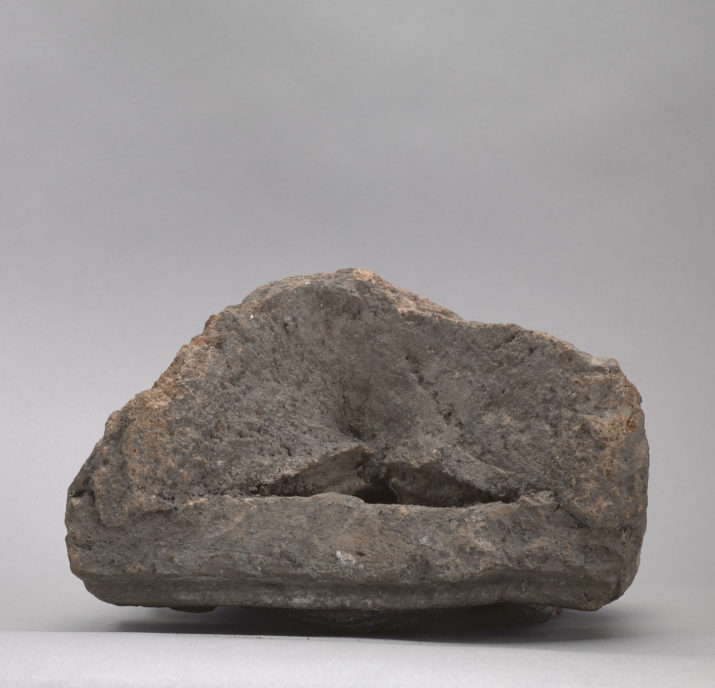
This is part of our Campus Spotlight on Columbia University and the Université Paris 1, Panthéon-Sorbonne.
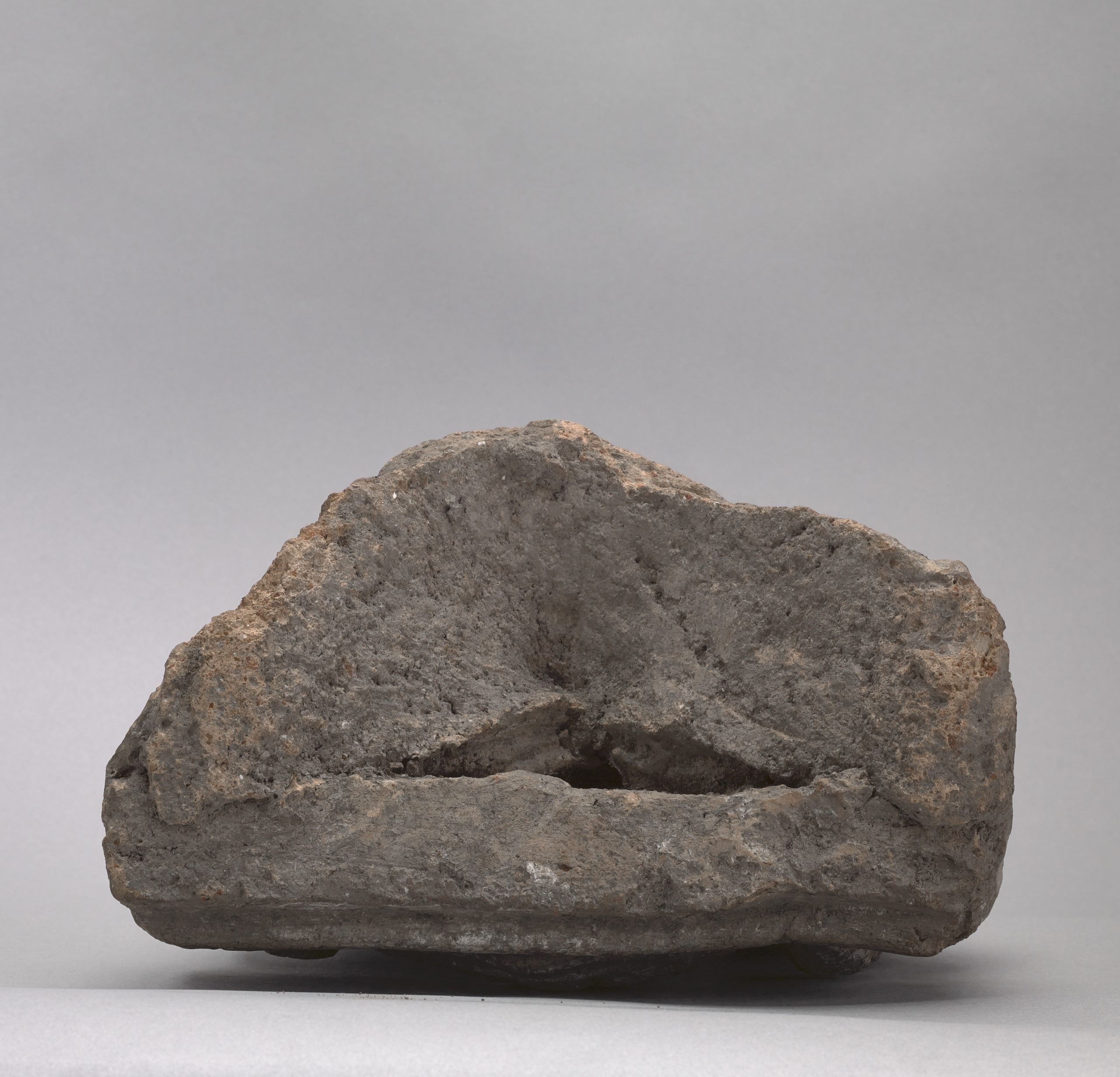
Fig. 1. Terracotta antefix seen face-down with the terminal imbrex attached to the decorated face. Italian, Gorgon Antefix,first half of first century, terracotta, H. 7 13/16 x W. 7 1/2 in. (20 x 19 cm), thickness (end of imbrex to front of plaque): 5 1/8 in. (13 cm), Art Properties, Avery Architectural and Fine Arts Library, Columbia University, George N. Olcott Collection (C00.1520.055). Photographed by Dwight Primiano, Avery Architectural and Fine Arts Library.
An antefix discreetly rests face-down on a storage shelf in Columbia University’s Art Properties collection. The object is readily identifiable by its terminal imbrex, or cover-tile, which remains attached to the decorative roof tile (Fig. 1). When installed, this antefix would have been one of many lining the eaves of a pitched roof, providing additional protection from water and wind. Lifting this tile reveals the polychromed visage of a Gorgon—the pigmentation, although worn, belies its original vibrancy (Fig. 2). White, red, and yellow can be seen on the surface of the terracotta tile. The face sports a diadem with rows of curls falling on both sides, which frame almond shaped eyes, a wide nose, and a slightly upturned mouth. Four high relief serpentine palmette leaves curl toward a central stalk located directly above the Gorgon’s crown. Between each sinuous leaf appears a smaller, teardrop shaped one in bas-relief. Two striated wings extend from the knot tied just underneath Gorgon’s chin; these terminate in badly damaged heads. Below, a listel serves as a plain horizontal border that marks the end of the decorative surface.
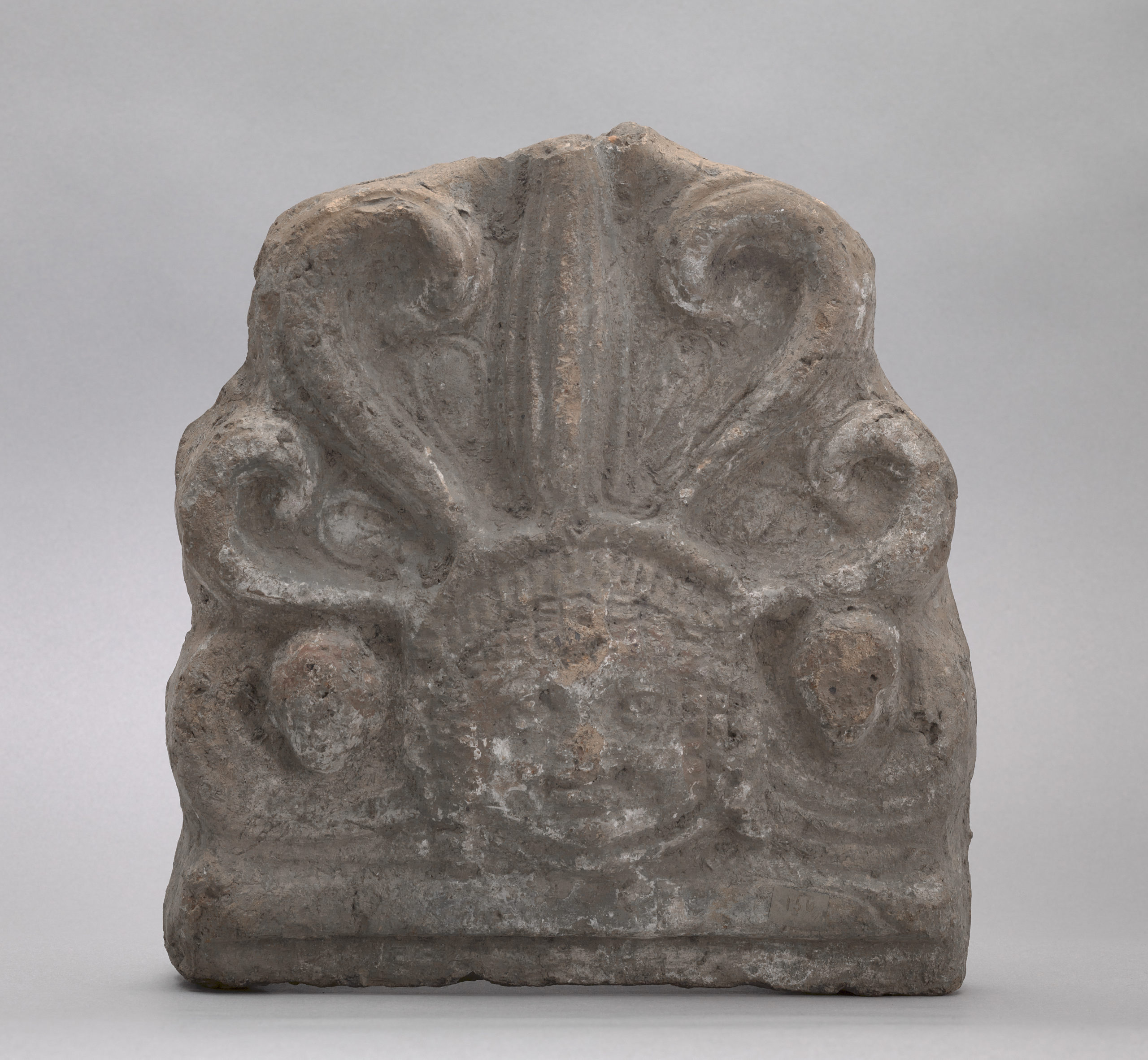
Fig. 2. Italian, Gorgon Antefix, first half of first century, terracotta, H. 7 13/16 x W. 7 1/2 in. (20 x 19 cm), thickness (end of imbrex to front of plaque): 5 1/8 in. (13 cm), Art Properties, Avery Architectural and Fine Arts Library, Columbia University, George N. Olcott Collection (C00.1520.055). Photographed by Dwight Primiano, Avery Architectural and Fine Arts Library.
The tile’s elaborate features are matched by its complex history, particularly its obscured provenance. Based on Art Properties’ card catalogue, it has been suggested that the antefix dates from the third century BCE and was a part of the decorative program of the Lacus Iuturnae.[1] This information is somewhat misleading. Following further inspection and investigation, the antefix must be understood as a part of a larger gift transferred from Albert W. Van Buren to George N. Olcott in 1908. Additionally, the antefix was likely made in the first century CE based on the typological comparison to extant antefixes. In order to convey the complicated history of this object, this article unfolds by first contextualizing Van Buren’s gift to Olcott before turning to the identification of the antefix.
All eleven objects that Van Buren gifted to Olcott were recorded in two card catalogues and a handwritten inventory stored in both Art Properties and Columbia University’s Rare Book and Manuscript Library.[2] Our antefix is referenced as accession number 156, which corresponds to the surviving number written on a piece of tape stuck to the right side of the antefix’s listel. Both the card catalogue and the inventory in Olcott’s notebooks document a purchase date ranging between 1902–1903. The veracity of the card catalogue can be confirmed by another artifact that was included in this cache of objects. One alabaster alabastron listed in the inventory and card catalogue remains in Art Properties (Fig. 3). The small vessel was purchased in Larnaka, Cyprus in 1904 by Van Buren and corresponds to another alabastron—also purchased in 1904 in Larnaka—currently stored in Smith College’s Van Buren Antiquities Collection.[3] Although the Van Buren Antiquities Collection does not have comparable examples of architectural terracottas, the connection between alabastra aligns Van Buren’s gift to Olcott with the divestiture of the collection he amassed between 1902–1906.
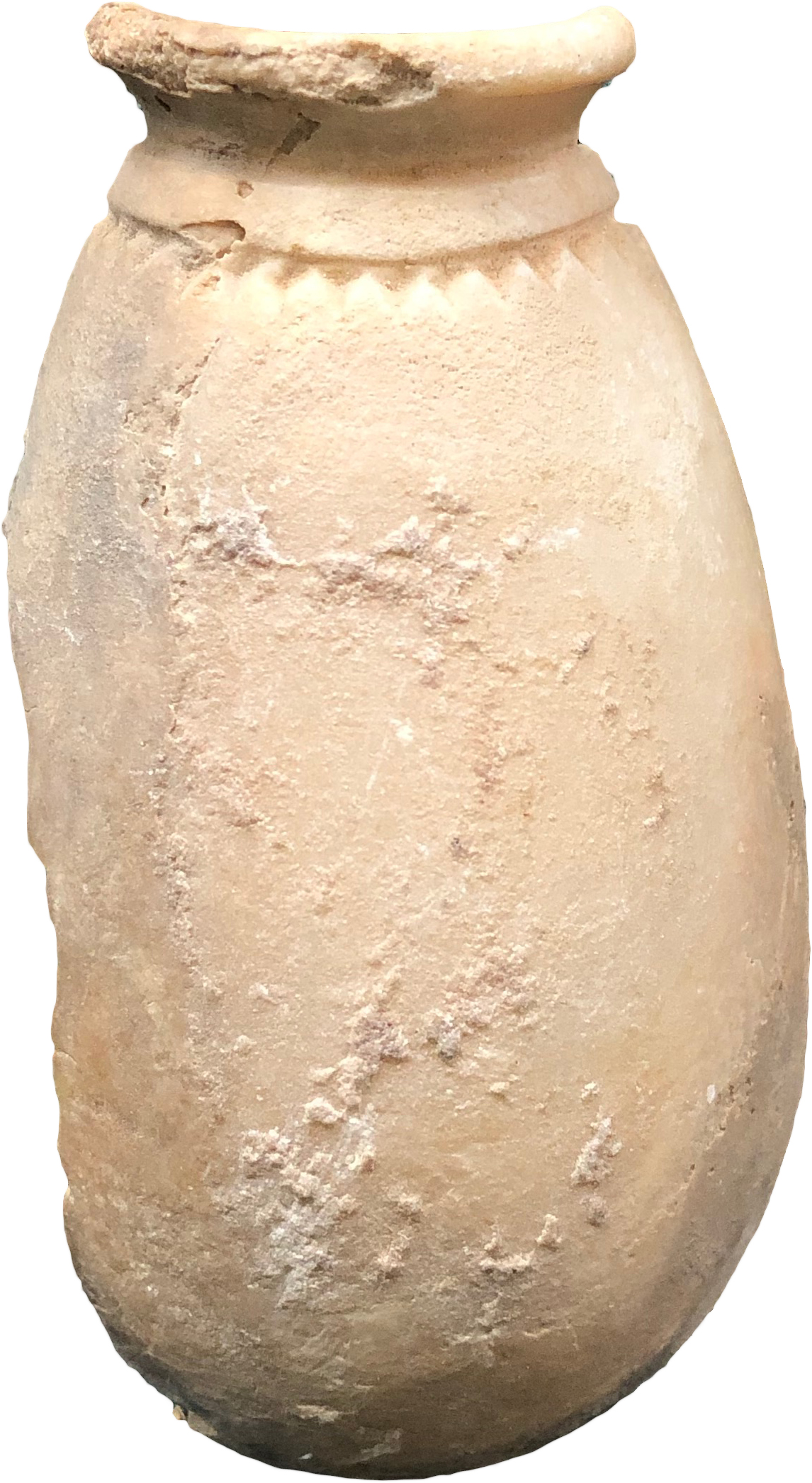
Fig. 3. Cypriot, Alabastron, date unknown, alabaster, H. 3 7/16 x W. 1 13/16 x D. 11/16 in. (8.8 x 4.6 x 1.7 cm), Art Properties, Avery Architectural and Fine Arts Library, Columbia University, George N. Olcott Collection (C00.1520.056). Photographed by Joseph Woldman.
During those four years, Van Buren was a fellow at the American School of Classical Studies—now the American Academy—in Rome, purchasing eighty-one objects, not including the eleven artifacts he gifted to Olcott.[4] Following the completion of twelve research projects, Van Buren returned to America in 1906 to accept a teaching position at Yale and brought his growing collection with him.[5] Little did he know that the American School would offer him a position to serve the institution as a lecturer and their librarian in 1908.[6] Unsure of how long his tenure in Rome would last, Van Buren deposited the majority of his collection in Phelps Hall of Yale University.[7] In 1925, Van Buren realized that his permanent return to the US was unlikely and subsequently sold the items on deposit at Yale to Professor F. Warren Wright of Smith College for one hundred dollars.[8]
Although there is no explicit description of Van Buren’s gift to Olcott, we can use the alabastra in Art Properties and the Van Buren Antiquities Collection at Smith College to hypothesize the motive behind this transfer. Likely, the 11 objects given to Olcott were part of the collection Van Buren formed while he was a fellow at the American School. Furthermore, Olcott was directly connected to the School—he was a Drisler fellow in 1896 and continued to receive support from the school between 1897 and 1898 following a period of severe illness that disrupted his research.[9] Later, in 1908/09, Olcott served as an “Associate” of the American School, directly connecting both him and Van Buren through the nexus of the school.[10] It is feasible that as Van Buren was preparing to return to Rome in 1908, he gave Olcott a portion of his collection instead of storing everything at Yale.
Yet, this information does not help us identify the antefix under consideration. The suggestion that the roof tile decorated the Lacus Iuturnae in the third century BCE is actually a conflation of two separate catalogue cards in Art Properties’ archives.[11] The confusion stems from a second card in Olcott’s catalogue that documents an “antefixa” of a Gorgon-type that was from the Lacus Iuturnae.[12] However, this card bears the accession number 438 and it does not indicate that Van Buren gifted it to Olcott. The card that does share an accession number with our antefix lists the provenance as “unknown.”[13] For this reason, the two cards likely reference different antefixes in Olcott’s collection, which unfortunately means that one roof tile has been lost.
This assessment is borne out by the antefix’s formal elements and their comparison to other extant tiles, particularly those excavated from the Lacus Iuturnae in the Forum Romanum. The area under discussion was located in the immediate vicinity of the Temple of Castor and Pollux, which was one subject of Van Buren’s research while he was a fellow at the American School of Classical Studies in Rome.[14] However, Van Buren does not intensively discuss the architectural decoration on the temple or the surrounding structures.[15] More recent excavations of the Temple of Castor and Pollux, conducted by the Institutum Romanum Finlandiae between 1982–1985, did uncover a number of antefix fragments that date from the third century BCE, but none of these correspond typologically to the tile in Art Properties.[16]
Instead, the antefix corresponds to a mold in use in the first century CE. Pensabene and Sanzi di Mino’s two-volume catalogue of antefixes in the Museo Nazionale Romano establish antefix Type 99, which features a palmette and a crowned Gorgon head with additional heads that emerge from wings.[17] They date this type to the first half of the first century CE. Three antefixes of this type are listed—two do not have a known provenance, whereas one was discovered in the Largo di Santa Susanna.[18] The examples from the Museo Nazionale Romano are not as complete as the antefix from Art Properties; substantial passages of the five-leaved palmette and the wings are missing from those illustrated in Pensabene and Sanzi di Mino’s text.[19] In an earlier publication, Anselmino describes four antefixes in the former Antiquarium Comunale that adhere to this type.[20] However, the best-preserved Type 99 antefix was found in Nemi.[21]The Nemi and Art Properties antefixes are nearly identical—the Nemi tile can be differentiated by its lack of a separately articulated listel underneath the winged Gorgon head. Although Ucelli’s description of this antefix suggests that the terracotta tile would have been “(vividly painted),” he does not specifically mention any remnants of color.[22]
Without additional information connecting the Art Properties antefix to a specific findspot or excavation, the exact provenance of the roof tile will remain a mystery. However, the tile must have been produced from a mold in use during the first century CE. Questions still remain. From whom and from where did Van Buren purchase this object? Furthermore, the suggestion that his gift to Olcott in 1908 was part of a larger collection remains a hypothesis. Even though many misconceptions about the antefix have been overturned, the search for more answers continues. Until then, the antefix unobtrusively remains in Art Properties, its face as hidden as its complete history.
Joseph Woldman is a PhD candidate in Columbia University’s Department of Art History and Archaeology. His dissertation explores the impact of faces as a primary motif in Etruscan art and architecture from the sixth and fifth centuries BCE.
References
[1] Curatorial Files, George N. Olcott Collection (Olcott no. 156, Olcott no. 468), Art Properties, Avery Architectural and Fine Arts Library, Columbia University.
[2] Curatorial Files, George N. Olcott Collection, Art Properties, Avery Architectural and Fine Arts Library; George N. Olcott Papers, 1869–1912, MS-1620, Box 1, Epigraphy Book 3 and Box 2, Cards, Rare Book and Manuscript Library, Columbia University. The list includes: an inscription (Olcott no. 148), a bronze fibula of the sanguisuga type (Olcott no. 149), a Type F arrowhead from Chaeroneia (Olcott no. 150 = B 150.42), an alabaster alabastron (Olcott no. 151 = PC 151), a bucchero phiale (Olcott no. 152 = PE 55.152), a small pitcher with a twisted handle (Olcott no. 153), a fragment of an alabaster alabastron (Olcott no. 154), a figurine of a draped female (Olcott no. 155), a black-figured lekythos (Olcott no. 157), a fragment of a marble labrum an architectural terracotta with an “egg and dart” motif (Olcott no. 159).
[3] Curatorial Files, George N. Olcott Collection (Olcott no. 154), Art Properties, Avery Architectural & Fine Arts Library; for the second alabastron: 6th century BCE. Alabastron. container. Place: Smith College, Caverno Room (Northampton, Massachusetts, United States). <https://library.artstor.org/asset/SS37318_37318_37676359>; see Lucia Carbone and Joe Sheppard, “The Olcott Coin Collection at Columbia University,” ANS Magazine (2019): 21 for the sale of 14 Trajanic denarii that were purchased by Olcott in 1911.
[4] Scott Bradbury, “History of the Van Buren Antiquities,” 2, last modified September 7, 2017, <www.smith.edu/sites/default/files/media/Documents/Classics/Caverno_History.pdf>; Katherine A. Geffcken, “A History of the Collection,” in The Collection of Antiquities of the American Academy in Rome, ed. Larissa Bonfante and Helen Nagy, (Ann Arbor, 2015), 46.
[5] Geffcken, “A History of the Collection,” 41.
[6] Geffcken, “A History of the Collection,” 41.
[7] Bradbury, “History of the Van Buren Antiquities,”2.
[8] Geffcken, “A History of the Collection,” 46, note 99.
[9] Geffcken, “A History of the Collection,” 57.
[10] Geffcken, “A History of the Collection,” 57.
[11] Curatorial Files, George N. Olcott Collection (Olcott nos. 156 and 438), Art Properties, Avery Architectural & Fine Arts Library.
[12] Curatorial Files, George N. Olcott Collection (Olcott no. 438), Art Properties, Avery Architectural & Fine Arts Library.
[13] Curatorial Files, George N. Olcott Collection (Olcott no. 156), Art Properties, Avery Architectural & Fine Arts Library.
[14] For an overview of the site, see Eva Margareta Steinby, “Transformations of public space at the Lacus Iuturnae.” in Public and Private in the Roman House and Society, eds. Kaius Tuori and Laura Nissin (Portsmouth, 2015), 31–48.
[15] Albert W. Van Buren, “The Temples of Castor and of Concord in the Roman Forum,” The Classical Review 20, no. 1 (February 1906): 77–84; Van Buren, “On the Temples of Castor and of Concord,” The Classical Review 20, no. 3 (April 1906): 184.
[16]Karen Slej and Mats Cullhed, The Temple of Castor and Polux: The finds and the trenches, 2:1–2 (Rome, 2008), 42, figs. 248 and 252.
[17] Patrizio Pensabene and Maria Rita Sanzi di Mino, Museo Nazionale Romano. Le Terrecotte. III, 1–2 (Rome, 1983), 166.
[18] Pensabene and di Mino, Le Terrecotte, 166–167.
[19] Pensabene and di Mino, Le Terrecotte, tables LXXVII-LXXVIII.
[20] Lucilla Anselmino, Terrecotte Architettoniche. I – Antefisse (Rome, 1977), 106–107, table XI.
[21] Guido Ucelli, Le navi di Nemi (Rome, 1983), 193–194, fig 214.
[22] Ucelli, Le navi di Nemi, 193.

